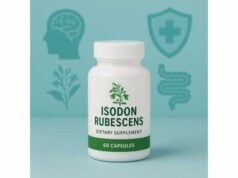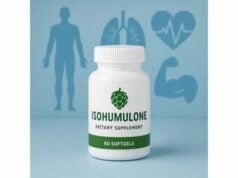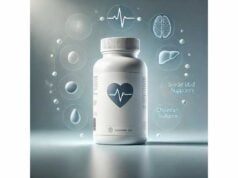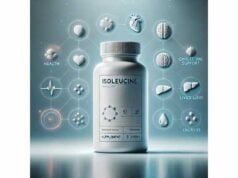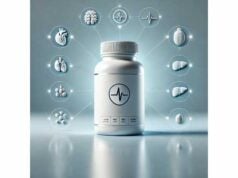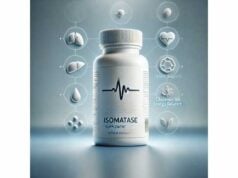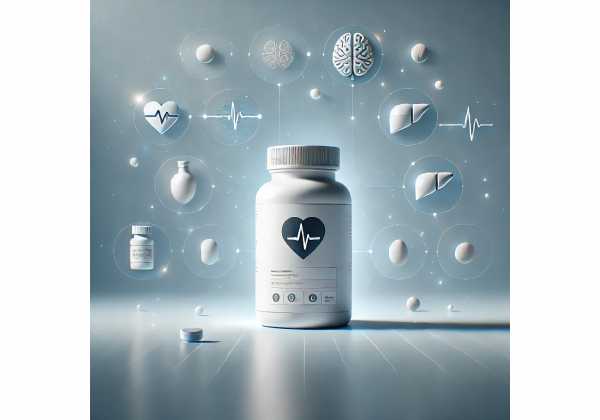
Isovitexin is a natural plant flavone (specifically, apigenin-6-C-glucoside) found in foods like mung beans, passionflower, bamboo leaves, and buckwheat. It has attracted interest for antioxidant and anti-inflammatory activity, metabolic support, and potential roles in bone and skin health. While much of the research is preclinical, the compound’s chemistry and early animal data suggest practical ways it may complement lifestyle measures for cardiometabolic wellness and resilience to oxidative stress. This guide translates the science into clear steps: what isovitexin is, how it behaves in the body, where benefits are most plausible, how to choose and take a supplement, and who should avoid it. We keep expectations grounded: isovitexin is not a stand-alone therapy, but a targeted phytochemical that may offer modest help when used thoughtfully alongside diet, movement, and medical care.
Key Insights
- May reduce inflammatory signaling and oxidative stress while supporting metabolic balance in preliminary studies.
- Shows oral bioavailability in animals; formulation and taking with food likely improve absorption.
- Typical supplemental range used by manufacturers: 50–150 mg/day, taken with meals for 8–12 weeks before reassessment.
- Avoid during pregnancy or breastfeeding and in hormone-sensitive or active liver conditions without clinician guidance.
- Safety caveat: interactions are possible with drugs affected by cytochrome metabolism or fat absorption; separate dosing when unsure.
Table of Contents
- What is isovitexin and how does it work?
- What benefits are realistic today?
- How to take isovitexin: dosage and timing
- Bioavailability and metabolism factors
- Safety, side effects, and who should avoid it
- What the evidence says so far
What is isovitexin and how does it work?
Isovitexin is a member of the flavonoid family, a group of polyphenols widely distributed in edible plants. Chemically, it is apigenin with a glucose attached directly to the carbon skeleton (a C-glycoside), which makes it more resistant to breakdown in the gut than the more common O-glycosides. That stability can change where and how it is absorbed, the form it circulates in, and which tissues experience the highest exposure.
Because isovitexin is moderately lipophilic and typically circulates as conjugates (glucuronides and sulfates), its activity in the body depends on two things: (1) direct interaction of the parent or deconjugated compound with cellular targets, and (2) its role as a signaling cue that nudges stress-response pathways. The most consistent mechanistic themes across experimental models include:
- Antioxidant response activation. Isovitexin can trigger endogenous defenses (for example, the Nrf2-HO-1 axis). Rather than simply scavenging free radicals, it appears to encourage cells to make more of their own protective enzymes, which is a more durable way to manage oxidative stress.
- Inflammation modulation. It dampens pro-inflammatory signaling (often involving NF-κB and MAPK pathways). In tissues like lung, cartilage, and liver, this translates into lower levels of cytokines and enzymes that drive inflammatory damage.
- Mitochondrial and metabolic effects. Studies in metabolic and bone biology models suggest improved mitochondrial function and shifts in glucose and lipid handling. In bone, isovitexin has shown anabolic signals (supporting osteoblast activity) while slowing markers of resorption.
- Antimicrobial and barrier support. Laboratory work indicates direct interference with specific bacterial virulence factors and preservation of tissue barriers under stress. Though promising, these findings require careful human translation.
A simple way to picture its role is this: isovitexin behaves like a “tuning molecule” for cellular stress, coaxing cells to restore balance rather than hammering a single receptor. That is why effects often look small but multidirectional—less inflammatory noise, better redox tone, and steadier energy signaling across multiple tissues.
Food sources contribute only modest amounts, and content varies with plant variety and processing (e.g., sprouting mung beans increases levels). Supplements use standardized plant extracts to provide consistent milligram doses that would be impractical to obtain from food alone. Even so, isovitexin should be considered an adjunct to—not a replacement for—core health habits.
What benefits are realistic today?
Early research on isovitexin spans many systems, but the strongest, most coherent signals cluster around inflammation control, oxidative-stress defenses, metabolic balance, bone support, and skin resilience. Here is how these map to practical outcomes:
1) Calmer inflammatory tone in stressed tissues.
In models of acute tissue stress—such as lipopolysaccharide-induced lung injury or IL-1β–challenged cartilage—supplementation with isovitexin lowers inflammatory markers, reduces oxidative damage, and preserves structural proteins. In plain language: cells fire fewer inflammatory signals, and antioxidant defenses ramp up. For everyday users, the realistic expectation is gentler support to help the body cope with inflammatory surges associated with diet, pollution, or strenuous exercise. It is not a substitute for anti-inflammatory drugs in acute illness.
2) Antioxidant support the body generates itself.
Unlike taking large doses of direct antioxidant vitamins, which can sometimes blunt training responses, polyphenols such as isovitexin tend to induce endogenous defenses. This is a “teach a cell to fish” effect: brief molecular cues lead to a longer-lasting increase in enzymes like heme oxygenase-1 and glutathione-related systems. Users often describe this as improved “stress tolerance” or faster recovery from hard days, though such experiences are subjective and should be anchored by objective markers when possible.
3) Metabolic and glycemic context.
In rodent and cell studies, isovitexin improves insulin signaling pathways, tempers post-meal glucose excursions, and influences lipids. The effect sizes vary by model and formulation. For a person practicing good nutrition and activity, isovitexin may add small, cumulative benefits—think a nudge rather than a leap. Where benefits are most plausible: individuals with borderline triglycerides, mild abdominal adiposity, or post-prandial glucose spikes. For diagnosed diabetes or dyslipidemia, isovitexin should only be considered as an adjunct within a clinician-directed plan.
4) Bone biology signals.
Animal work suggests isovitexin can support bone formation and reduce resorption, potentially through adiponectin-receptor and mitochondrial pathways. If confirmed in humans, this could matter for midlife bone maintenance and exercise recovery. At present, this is an encouraging signal rather than an approved therapy. Strength training, adequate protein, vitamin D, and calcium remain the foundation.
5) Skin and photoprotection.
Flavones like isovitexin have shown the ability to reduce UV-induced oxidative stress and matrix degradation in experimental systems. Formulators sometimes include it in topical products for antioxidant shielding. Oral use for skin health is an emerging area; real-world benefits likely depend on overall antioxidant intake and sun-safe habits.
What not to expect.
Claims around broad anticancer effects, dramatic weight loss, or complete symptom relief in chronic conditions exceed current human evidence. Isovitexin does not replace medications for high-risk conditions and should not be used to self-treat serious disease. In most cases, the practical value lies in incremental improvements that complement sleep, diet, and movement.
How to track value.
If you are experimenting with isovitexin for wellness or metabolic balance, anchor expectations to measurable outcomes: fasting triglycerides, waist circumference, post-meal glucose checks, or symptom logs (e.g., exercise recovery, skin tolerance in sun-exposed seasons). Reassess after 8–12 weeks, then decide whether to continue.
How to take isovitexin: dosage and timing
Because isovitexin is a dietary phytochemical rather than an approved drug, there is no official therapeutic dose. Supplement makers typically standardize extracts from plants such as passionflower, bamboo leaf, or mung bean sprouts and list the isovitexin content per serving. A practical, conservative approach looks like this:
Suggested supplemental range
- Start at 50 mg/day of isovitexin from a standardized extract.
- Titrate gradually to 100–150 mg/day if well tolerated and if your goals include metabolic or recovery support.
- Divide the daily amount with meals (e.g., 50 mg with breakfast and 50 mg with dinner) to spread exposure and reduce stomach upset.
These amounts align with what many manufacturers provide per capsule and are intended for short-term evaluation (8–12 weeks). If a product combines isovitexin with vitexin or other flavonoids, consider the total flavonoid dose and begin on the lower end.
Timing and absorption tips
- Take with a mixed meal that includes fat to support absorption and transport.
- Consistency matters: daily use is more likely to produce a detectable signal than sporadic dosing.
- Hydrate well; polyphenol conjugation and transport depend on healthy liver and kidney function.
Stacking with intent
- Metabolic balance: Pair with soluble fiber at meals (oats, psyllium) and a brisk post-meal walk to target glucose and triglyceride spikes from multiple angles.
- Exercise recovery: Combine with protein and creatine to support muscle remodeling; keep total polyphenol intake moderate on heavy training days to avoid blunting desired adaptations.
- Skin resilience: If you use a topical antioxidant, oral isovitexin may complement but not replace sunscreen and sun-protective clothing.
Cycles and reassessment
- Consider 8–12 weeks on, followed by a 2–4 week break to reassess baseline symptoms and labs.
- If no measurable or felt benefit, discontinue rather than “dose chasing.”
Choosing a product
- Look for clear standardization (e.g., “isovitexin, 100 mg per capsule”) rather than vague “plant blend” language.
- Seek brands that publish third-party Certificates of Analysis confirming identity, potency, heavy metals, and microbial safety.
- Prefer formulas that disclose the vitexin:isovitexin ratio, since these sister compounds can behave differently.
- Oil-based softgels or modern delivery systems (e.g., microencapsulation) may improve exposure; powders can work when taken with food.
When food is enough
- If you already eat a plant-forward diet rich in legumes, sprouted grains, leafy greens, and tea, your overall polyphenol exposure is likely high. In that case, try focusing on dietary sources first and track whether you need a supplement at all.
Bioavailability and metabolism factors
Not all polyphenols behave the same in the body. Isovitexin’s C-glycoside structure makes it more resistant to digestive breakdown than many flavonoids, which affects absorption routes and tissue distribution. Four practical points explain most of the variability people see:
1) Delivery system changes exposure.
Raw powders can be absorbed, but formulation matters. Animal pharmacokinetic work shows that encapsulation or microcapsule technologies can raise peak levels and overall exposure compared with traditional extracts. For a consumer, this means two products with the same listed milligrams may deliver different amounts to the bloodstream. If you switch brands and notice a change in effect at the same dose, formulation could be the reason.
2) Conjugation is not the end of the story.
After absorption, isovitexin is commonly attached to glucuronic acid or sulfate in the intestinal wall and liver. These conjugates circulate and can be deconjugated in tissues or at sites of inflammation, releasing the active aglycone near where it is needed. In other words, the body uses conjugation like a “shipping label,” which helps explain why plasma levels may not fully capture local effects.
3) The gut microbiome shapes outcomes.
Your microbiota can transform polyphenols, change bile acid signaling, and modulate how much of a dose remains in the lumen versus enters circulation. Diets that support a diverse microbiome—fiber-rich foods, fermented products, moderate polyphenol variety—tend to yield more stable responses. Conversely, very low-fiber diets or broad antibiotic use may blunt effects.
4) Tissue targets likely include liver, bone, and skin.
Preclinical studies suggest that the liver sees meaningful exposure, which fits with observed shifts in oxidative stress and lipid handling. Bone effects may arise from mitochondrial and adiponectin-receptor signaling in osteoblasts, while skin models show reduced matrix degradation under oxidative stress.
How to tilt bioavailability in your favor
- Take isovitexin with food containing 10–20 g of fat (for example, yogurt with nuts, eggs and avocado, or olive-oil-dressed salad).
- If you experience stomach upset, split doses and take them with meals.
- Combine with daily fiber (legumes, oats, psyllium) and fermented foods to support a microbiome environment that metabolizes polyphenols predictably.
- Remember that more is not always better. Because activity often comes from signaling, chasing very high doses may not add value and can raise the chance of interactions.
Measuring personal response
- For metabolic goals, use baseline and 8–12 week checks: fasting triglycerides and non-HDL cholesterol; if feasible, a simple two-hour post-meal glucose profile on the same breakfast before and after your trial.
- For bone goals, prioritize exercise and nutrition first; speak with a clinician about when bone density testing makes sense.
- For skin goals, compare seasonal photos and note sun tolerance alongside consistent sunscreen use.
Safety, side effects, and who should avoid it
Overall, isovitexin appears well tolerated in animal and early human-adjacent formulations, but robust long-term safety data in people are limited. The prudent approach is to start low, monitor, and involve a clinician if you have medical conditions or take daily medications.
Common, usually mild effects
- Gastrointestinal: nausea, bloating, or looser stools—more likely if taken on an empty stomach. Taking with food and dividing doses usually helps.
- Headache or light fatigue: uncommon; consider dose reduction and hydration.
- Allergy: rare; discontinue if you suspect a reaction.
Hormonal considerations
- Isovitexin itself is not a strong phytoestrogen, but plant extracts may contain related flavonoids. If you notice changes in menstrual patterns or breast tenderness, pause and reassess with a clinician. People with hormone-sensitive conditions should avoid use unless medically supervised.
Liver and kidney health
- Polyphenols are processed by the liver and eliminated via bile and urine. If you have active liver disease, unexplained elevated liver enzymes, or significant kidney impairment, do not start isovitexin without medical guidance. Alcohol is not a delivery method; keep intake within low-risk guidelines.
Drug interactions to consider
- Anticoagulants and antiplatelets: While clear clinical interactions with isovitexin are not established, caution is wise with warfarin or direct oral anticoagulants; keep your prescriber informed.
- Drugs sensitive to first-pass metabolism: Flavonoids can modulate enzyme systems in the lab; space isovitexin several hours away from narrow-therapeutic-index drugs when possible.
- Agents that alter fat absorption or bind compounds in the gut: Separate doses by 3–4 hours if you use bile acid sequestrants or other binders to avoid unpredictable exposure.
Who should avoid isovitexin (unless a clinician approves)
- Pregnant or breastfeeding individuals (insufficient safety data).
- Children and adolescents (lack of safety data during growth).
- People with hormone-sensitive cancers or active, uncontrolled endocrine conditions.
- Those with active liver disease or unexplained abnormal liver tests.
How to use it safely
- Document your baseline. Write down why you are using isovitexin and what you will measure.
- Start low (50 mg/day with food). Increase only if needed after two to four weeks.
- Reassess at 8–12 weeks. Continue only if you can identify a measurable or meaningful benefit.
- Pause around procedures. Stop non-essential supplements one to two weeks before surgery unless your care team advises otherwise.
What the evidence says so far
The literature on isovitexin has grown quickly, but it is still dominated by in vitro experiments and animal models. That means mechanisms are clearer than clinical outcomes. A realistic evidence snapshot looks like this:
Pharmacokinetics and formulation
- Modern analytical studies confirm measurable oral bioavailability in animals, with enhancements seen when isovitexin is delivered via microencapsulation or other advanced carriers. These studies also show considerable inter-individual variability typical of polyphenols. For consumers, the message is to focus on formulation quality and food timing rather than megadoses.
Inflammation and oxidative stress
- Multiple investigations demonstrate that isovitexin reduces inflammatory mediators and activates antioxidant programs in stressed tissues (for example, lung injury models). Reproducibility across systems strengthens confidence in this core activity, even if precise human dosing remains unsettled.
Metabolic health
- Reviews synthesizing diabetes-related work describe multitargeted actions, from improving insulin pathway signaling to moderating post-meal glucose in animals. These findings justify cautious human exploration but stop short of prescribing isovitexin as a treatment. Any metabolic benefit should be layered on top of diet and movement.
Bone biology
- In ovariectomized mouse models (a standard preclinical analog of postmenopausal bone loss), oral isovitexin improved markers of bone formation and strength, with reported bioavailability figures that support the feasibility of oral use. These data are promising but require human trials before clinical recommendations.
Antimicrobial and barrier effects
- Laboratory reports show direct inhibition of certain bacterial virulence factors and reduced coagulation triggers from specific pathogens. Translational significance remains to be established, but such data hint at broader tissue-protective roles under inflammatory stress.
Human evidence gaps
- There are no large, high-quality randomized trials of oral isovitexin as a stand-alone supplement in humans. Some human-adjacent work (e.g., topical formulations, food matrices, or complex botanical blends) is emerging, but individual contribution and optimal dosing remain open questions. Until those trials arrive, the best practice is to use isovitexin as a supportive adjunct, not a primary therapy.
Bottom line for readers
- If you are healthy and interested in resilience to oxidative stress or gentle metabolic support, a time-boxed, measured trial of a reputable isovitexin product—paired with clear goals and tracking—can be reasonable. If you live with chronic disease or take daily medications, involve your clinician from the outset.
References
- Dietary Flavonoids Vitexin and Isovitexin: New Insights into Their Functional Roles in Human Health and Disease Prevention (2025) (Systematic Review)
- Development and Validation of an HPLC-MS/MS Method for the Simultaneous Quantification of Vitexin and Isovitexin in Rabbit Plasma: Pharmacokinetic Insights on a Microcapsule Formulation (2025)
- Oral Administration of Isovitexin, a Naturally Occurring Apigenin Derivative Showed Osteoanabolic Effect in Ovariectomized Mice: A Comparative Study with Teriparatide (2022)
- Multitargeted effects of vitexin and isovitexin on diabetes mellitus and its complications (2021) (Systematic Review)
- Isovitexin Exerts Anti-Inflammatory and Anti-Oxidant Activities on Lipopolysaccharide-Induced Acute Lung Injury by Inhibiting MAPK and NF-κB and Activating HO-1/Nrf2 Pathways (2016)
Disclaimer
This guide is educational and is not a substitute for professional medical advice, diagnosis, or treatment. Supplements like isovitexin can interact with medications and health conditions and are not appropriate for everyone. Always consult a licensed healthcare professional before starting, stopping, or combining supplements, especially if you are pregnant or breastfeeding, have hormone-sensitive conditions, liver or kidney disease, or take prescription drugs. If you choose to try isovitexin, set clear goals, monitor your health and laboratory values, and discontinue if you experience adverse effects.
If this article was useful, please consider sharing it on Facebook, X (formerly Twitter), or your preferred platform, and follow us for more evidence-based wellness content. Your support helps us continue creating high-quality resources.

